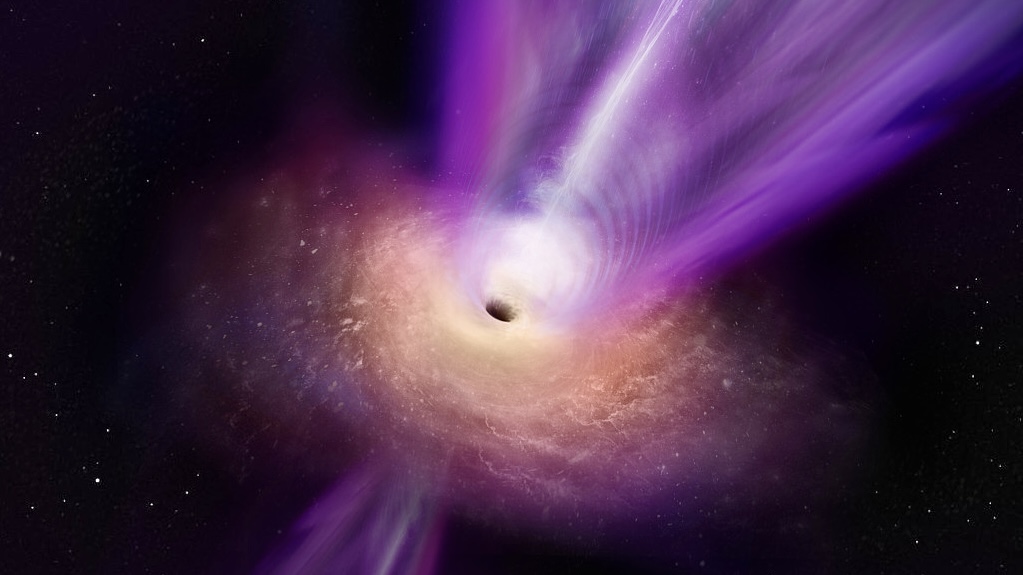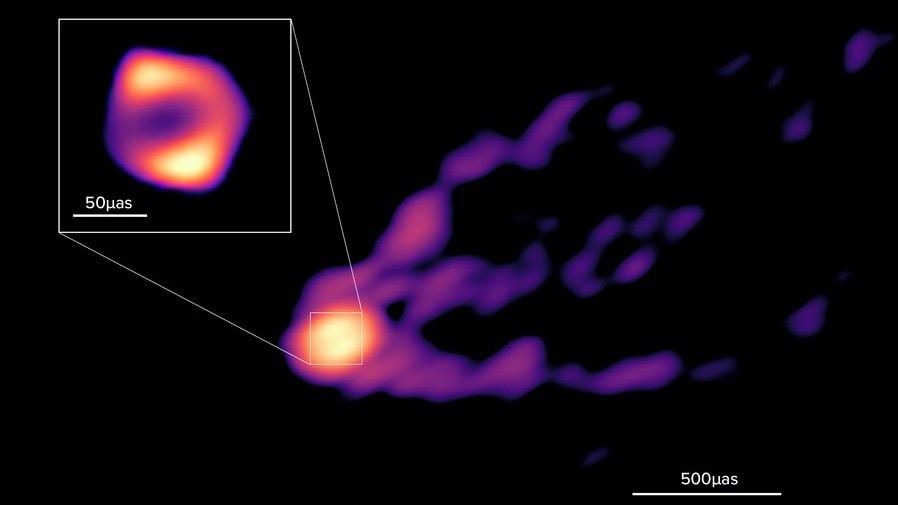01:16

An international team led by Chinese astronomers has unveiled a new image of the supermassive black hole at the center of elliptical galaxy Messier 87, or M87, featuring its accretion disk and the powerful jet of subatomic particles being ejected from the disk, according to a study published in the journal Nature on Wednesday.
The black hole of the M87 galaxy has a mass 6.5 billion times greater than that of the Sun and is 55 million light-years from Earth.
The image is the first of its kind to show the relation between the black hole's surrounding accretion disk and the jet. The disk is made of bright and rapidly rotating particles orbiting around the black hole, while the jet is accelerated particles traveling away from the black hole at nearly the speed of light.
The image will allow scientists to better understand supermassive black holes, their accretion disks and how these can power black hole jets, which are considered one of the most energetic events in the universe.

The image shows the jet and shadow of the black hole at the center of the M87 galaxy together for the first time, April 26, 2023. /Shanghai Astronomical Observatory, CAS
The image shows the jet and shadow of the black hole at the center of the M87 galaxy together for the first time, April 26, 2023. /Shanghai Astronomical Observatory, CAS
In April 2019, an image of a donut-like structure with a dark central region and a bright ring made international headlines as the first-ever image of a black hole.
A black hole can engulf matter in its immediate vicinity and eject powerful particles beyond the galaxy that harbor the black hole at the center. Astronomers have been trying to observe the origin of the jet as close as possible to better understand how the energetic jets are created.

A screenshot of the study published in the journal of Nature.
A screenshot of the study published in the journal of Nature.
The latest published M87 black hole image was obtained with the Global Millimeter VLBI Array (GMVA), the Atacama Large Millimeter/Submillimeter Array (ALMA), and the Greenland Telescope (GLT). They formed a network of radio telescopes around the globe, and astronomers used light captured at different locations to build an image with a resolution similar to that of a virtual Earth-size telescope.
Lu Rusen from the Shanghai Astronomical Observatory is the lead author of the research paper published in the latest issue of Nature. According to Lu, astronomers once observed the black hole and the energetic jet in separate images, and the new image captures the black hole and the jet in one photo at a new wavelength.
The ALMA and GLT improved the resolution and sensitivity of the observations and helped realize the imaging of the ring around the M87 black hole at a wavelength of 3.5 millimeters. It's like an astronaut on the Moon looking at a circular fill light with a diameter of 13 centimeters on Earth.
Lu said that at the wavelength of 3.5 millimeters, researchers could see how the jet emerges from the ring of emission around the central supermassive black hole.
He added that the observations had revealed more details about the M87 black hole.
Shen Zhiqiang, director of the Shanghai Astronomical Observatory, said that observations on M87 will continue to unravel how the black hole can launch powerful jets and other complicated processes near the black hole.
(With input from Xinhua)